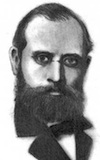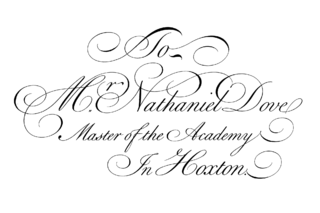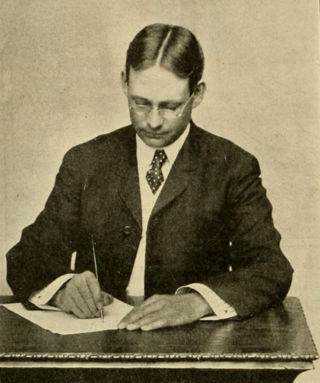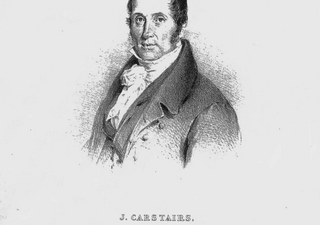
Penmanship is the technique of writing with the hand using a writing instrument. Today, this is most commonly done with a pen, or pencil, but throughout history has included many different implements. The various generic and formal historical styles of writing are called "hands" while an individual's style of penmanship is referred to as "handwriting".

Handwriting is the writing done with a writing instrument, such as a pen or pencil, in the hand. Handwriting includes both printing and cursive styles and is separate from formal calligraphy or typeface. Because each person's handwriting is unique and different, it can be used to verify a document's writer. The deterioration of a person's handwriting is also a symptom or result of several different diseases. The inability to produce clear and coherent handwriting is also known as dysgraphia.

Cursive is any style of penmanship in which characters are written joined in a flowing manner, generally for the purpose of making writing faster, in contrast to block letters. It varies in functionality and modern-day usage across languages and regions; being used both publicly in artistic and formal documents as well as in private communication. Formal cursive is generally joined, but casual cursive is a combination of joins and pen lifts. The writing style can be further divided as "looped", "italic", or "connected".

Block letters are a sans-serif style of writing Latin script in which the letters are individual glyphs, with no joining.

Italic script, also known as chancery cursive and Italic hand, is a semi-cursive, slightly sloped style of handwriting and calligraphy that was developed during the Renaissance in Italy. It is one of the most popular styles used in contemporary Western calligraphy.

The D'Nealian Method is a style of writing and teaching handwriting based on Latin script which was developed between 1965 and 1978 by Donald N. Thurber (1927–2020) in Michigan, United States. Building on his experience as a primary school teacher, Thurber aimed to make the transition from print writing to cursive easier for learners.

Platt Rogers Spencer was the originator of Spencerian penmanship, a popular system of cursive handwriting. He was a teacher and active in the business school movement.

Charles Paxton Zaner was an American calligrapher, pen artist, and teacher of penmanship.

Getty-Dubay Italic is a modern teaching script for handwriting based on Latin script, developed in 1976 in Portland, Oregon, by Barbara Getty and Inga Dubay with the aim of allowing learners to make an easier transition from print writing to cursive.

Spencerian script is a script style based on Copperplate script that was used in the United States from approximately 1850 to 1925, and was considered the American de facto standard writing style for business correspondence prior to the widespread adoption of the typewriter. Spencerian script, an American form of cursive handwriting, was also widely integrated into the school system as an instructional method until the "simpler" Palmer Method replaced it. President James A. Garfield called the Spencerian script, "the pride of our country and the model of our schools."

The term "chancery hand" can refer to either of two distinct styles of historical handwriting.
The International Association of Master Penmen, Engrossers and Teachers of Handwriting (IAMPETH) is an international association for practicing and preserving the arts of calligraphy, engrossing and penmanship. IAMPETH was founded in 1949.

Michael Sull is an IAMPETH master penman and author living in Mission, Kansas, United States. An expert on penmanship, he was Ronald Reagan's calligrapher after his presidency and is known worldwide for his skill and teaching ability. He regularly teaches handwriting, calligraphy, and engrossing programs throughout the United States, Europe and Asia.

A copperplate script is a style of calligraphic writing most commonly associated with English Roundhand. Although often used as an umbrella term for various forms of pointed pen calligraphy, Copperplate most accurately refers to script styles represented in copybooks created using the intaglio printmaking method.
Zaner-Bloser, Inc., is a company headquartered in Columbus, Ohio, which publishes handwriting, reading, writing, spelling, and vocabulary programs.
Barchowsky Fluent Handwriting (BFH) is a modern teaching script for handwriting based on Latin script, developed in the late 20th century by Nan Jay Barchowsky in Maryland, US, with the aim of allowing learners to make an easier transition from print writing to cursive.

Edward Clarence Mills (1873–1962) was an American master penman and educator, noted for the Business Writing style of cursive handwriting.

A teaching script is a sample script that serves as a visual orientation for learning to write by hand. In the sense of a guideline or a prototype, it supports the demanding process of developing handwriting skills and abilities in a visual and illustrative way.

Joseph Carstairs was an English calligrapher and writing teacher who devised a new system and style of writing in the early 19th century. Carstairs's system emphasised a "bold and free writing" when he first introduced it in 1809. In 1814 he published "A New System of Teaching the Art of Writing" which set out the core tenets of his approach emphasizing "muscular movement" up and down the page in an effort to speed up the overall pace of writing. Carstairs was one of the key influences on later cursive writing developments in the United States by Benjamin F. Foster and, in turn, the development of Spencerian penmanship by Platt Rogers Spencer in the 1840s.

The Zaner-Bloser is a teaching script for handwriting based on Latin script as well as a system of penmanship instruction, which originated around 1904 at the Zanerian College of Penmanship in Columbus, Ohio. Charles P. Zaner (1864–1918) and Elmer W. Bloser (1865–1929), originally a Spencerian Method instructor, developed their teaching script with the aim of allowing learners an easier transition from print writing to cursive. The Zaner-Bloser Method first teaches block letters and then cursive in order to enable written expression as quickly as possible and thus develop the ability to write. Material relating to the method of instruction practiced by Zaner and Bloser is still being published by the Zaner-Bloser Company, a subsidiary of Highlights for Children.
















